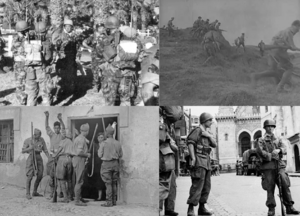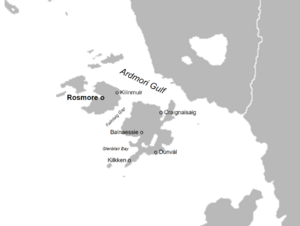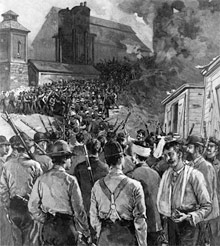Ardmori Civil War
| Ardmori Civil War | |||||||
|---|---|---|---|---|---|---|---|
 (Clockwise from top left) members of the Arcerion Parachute Regiment converse before a patrol; International Brigade fighters of the Ardmori Socialist Front conduct an assault; Royal Ardmori Army troops patrol streets during attempts to quell riots and insurrection; Ardmori Socialist troops search a town for Loyalist collaborators. | |||||||
| |||||||
| Belligerents | |||||||
|
Ardmore | Ardmori Cooperative | ||||||
| Commanders and leaders | |||||||
| King Coilean Ó Canann | |||||||
| Units involved | |||||||
|
Royal Ardmori Army Royal Ardmori Navy Ardmori Air Corps |
Ardmori Liberation Army National Ardmori Front New Ardmori People's Republic | ||||||
| Casualties and losses | |||||||
| significant | significant | ||||||
The Ardmori Civil War, also known as the Liberation War in the Ardmori Cooperative, was a military and civil conflict that lasted four years (1927-1931) in Southern Levantia. Ardmore had undergone a significant period of industrialization and rapid urbanization in the wake of the industrial revolution. Massive social unrest caused by economic disparity and a rigid class system led to a series of open riots and protests against the Royal Family of Ardmore and the resulting crackdowns created a significant split between pacifist factions (Appeasers) and the hardline Royal family members (Loyalists). The conflict would eventually engulf the entirety of Ardmore, with its colonial troops from Arcerion entering the fray on the Loyalist side, and eventually withdrawing after the armistice negotiated by Kiravia.
Background

Industrialization in Ardmore was mostly centered around rapidly growing urban centres in the South of Ardmore, on the island of Great Ardmore. Due to the vast amount of manufacturing, industrial plants, and refineries that had sprung up as corporations and business capitalized on the amount of cheap labour available on the relatively poor islands, the vast majority of the wealth in Ardmore, as well as the economic progress was centralized in the North, in the Capital City of Rosmore due to the nationalization of many companies and the social and political upper class being disproportionately settled there.
Unions for the betterment of labour conditions and working conditions in the factories and plants in South Ardmore began to take hold, particularly in Dunvál, the largest city in Great Ardmore. Members of the New Worker's Party began to hold open rallies, organized by a prominent pair of shift managers in the city. Ardghar Mac Shuibhne had been educated in Vithinja, as a student of new political theories based on syndicalism policies. Ardghar's contemporary, Ros Mac Daibhéid, was a socialist politician and labour leader who had been ejected from the Ardmori Parliament following a series of political stunts involving bringing child labourers and victims of industrial accidents into the Ardmori House of Commons.
Union Protest
Ardghar and Ros Mac spent most of 1926 speaking publicly in pubs, dance halls, and poor houses across Great Ardmore. The focus on the South Islands was largely due to the lessening Royal presence, as the Royal Army was undergoing a period of austerity and budget cuts, with Regiments withdrawing closer to garrisons and away from the industrial centres. This was combined with a significant amount of corruption amongst the Ardmore Royal Constabulary, the national and federal police and internal security force that protected the Crown's interest. Another major concern was the lack of a try gendarmerie to deal with the subversive activities of Ardghar and Ros Mac, giving them freedom of movement. The largest rally in Kilkken was held at the shift change of three neighbouring factories in the town's Northern District. Over two thousand shift workers, child labourers, and union activists listen to speeches on worker reform, industrial safety improvements, minimum wages, and pensions for long time employees. Ardghar had bribed sympathetic police officers who ensured the rally went unhindered, and over a thousand of the participants signed up for the New Worker's Party, which by the end of 1926 was nearing 10,000 members across Ardmore and was looking to establish other chapters and groups in the Northern Islands.
Despite protests from the educated Ardghar, Ros Mac demanded a political stunt outside of the Royal Palace in Rosmore. Ros Mac was determined to take the fight to both the Parliament and Royal Family, and planned a large protest on the day of the communion of several junior members of the Royal Family. The event was likely to have both King Coilean Ó Canann, as well as Prime Minister Teigue Ó hAinle, with several members of the cabinet and senior Royals. Planned for November 11th, 1926 several hundred protestors boarded vessels from Dunvál, arriving the day before the ceremony in Rosmore, staying in pubs, poor houses, and Salvation Army kitchens overnight before the event.
The Royal family was shocked when several hundred angry protestors descended onto the Rosmore Cathedral, and despite attempts by Ardghar to keep the union members and sympathizers peaceful, violent clashes broke out between police, Royal Guardsmen, and union members. The clash was over quickly, but it prevented the King and members of the Royal Family from entering the Cathedral, and several dozen policemen and union members were seriously injured, and at least two cabinet members were accosted by the crowd before swiftly being rescued by police. The King concluded that what had gone on thus far was unacceptable, and what was seen as a passing political fad was now quickly becoming an insurrection that threatened his hold on the Kingdom. Between Ardghar and Ros Mac, a serious rift emerged as they differed not only over politics and suggested courses of action on how to run the campaign to revolutionize their nation, but also on how to deal with the resulting fallout. Ros Mac, the militant communist who demanded a violent revolution to overthrow the ruling class for the workers saw this clash as the first battle in a war for a New Ardmore. Ardghar however was concerned that their activities would now draw the ire of the Royal Family, Constabulary, and ultimately the Royal Army.

Royal Crackdown and Suppression
Preparation continued by the New Worker's Party for a considerable increase in union signing drives, strikes, and protests against police brutality. However
angry secret police stuff everyone thinks its done
Socialist Uprising
everyone thought it was over
foreign support
-Revitalised support through foreign weapons and fighters
Early War (1927-1929)
Initial Conflicts
2 key battles put socialists on back foot on North Island
Ardghar and Ros Mac split and form two different communist uprisings
Ardghar - National Ardmori Front
Ros Mac - Armori Liberation Army
Battle of Hellman
north island, loyalists smash commies
Battle of Tuton
arrival of Arco paras, catch brigades retreating from hellman and destroy them, prevent them from evacuating most troops from the port
North Islands Campaign
-Infighting amongst commies allows Prince Regent (King is trapped on South island) to use Arco troops and Ardmori troops to solidify position and secure north island (Operation Treble)
Invasion of South Ardmore
Operation Pike
-Invasion of south island -initial success
-commies reform against new threat to the revolution
-few key battles, at least 1 stalingrad esque
Urcean Diplomatic Intervention
Urc basically ceases all economic support to Ardmore, orders all key allies to as well
Ardmore now only supported by Alstin and Arcerion
Government and military begin to collapse
Battle of Elliston
arco paras and light rifles battling in hills, commies lose
Siege of Wolford
tobrukl-esque, commies caught by loyalists
Battle of Dumbarton
commies relieve Taetal, loyalists get beaten
Late War (1930-1931)
Retreat from Wolford
-ardmori troops begin to break with mass execution of royals and armori government officials
-wavering ardmori support increases burden on arco troops
Evacuation of Taernsby
-arco generals see writing on the wall, begin an evacuation a la Manila to get loyalists to the north island
Battles of the Southern Marches
See: Operation Smatter
-retreat to north island (make it seem like a long march type deal)
Armistice and Legacy
-generic status quo
-armstice negotiated by @Kir ?
-2 countries emerge -arco withdrawal from Levantia